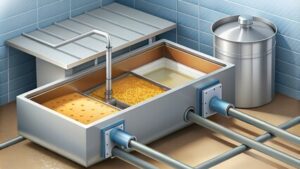Grease Trap Perth is a receptacle that kitchen wastewater flows through before entering a sewer waste system. This receptacle intercepts, captures and “traps” fats, oils and grease so they can’t gum up pipes and create costly clogs.

A well-maintained grease trap is a must for commercial food service facilities. Learn what goes into a grease trap and how it works so you can make the best decision for your facility’s needs.
A functional grease trap (also called a grease interceptor) reduces the amount of fats, oils and greases (FOG) that make their way into the sewer waste system. This helps prevent clogs, sewer backups and other problems that can result from FOG entering the main sewer line. Health inspectors typically require larger establishments to have a grease trap installed on site.
The basic design of a grease trap involves a tank, a pump, an inlet pipe and an outlet pipe. Wastewater flows through the inlet pipe into the trap where it is cooled with water. This helps separate the FOG from the wastewater, as the FOG is lighter in density and floats to the top of the tank while the cooled water – minus the FOG – continues draining to the sewer system.
Grease traps are designed with a variety of baffles and plastic wall structures that slow down the flow of wastewater into the trap. This gives the FOG time to rise to the surface and allows the filtered wastewater to continue flowing out of the inlet pipe into the sewer line.
Ideally, you should clean your trap at least once every three months. This will keep the trap from filling up too quickly and avoid clogs, which can cause wastewater to back up into your kitchen and other areas of your establishment. A full trap can also lead to unpleasant and costly sewer overflows.
To help prolong the life of your grease trap, you should scrape its walls and baffles during each cleaning. This will remove any adhered grease from the walls and allow for easier and more thorough cleaning. In addition, you should dispose of the collected grease properly to prevent blockages and environmental issues.
A clogged grease trap can be costly and a major headache for any commercial kitchen owner. A blocked grease trap can contaminate the kitchen environment, leading to food waste disposal issues and potential health and safety concerns for staff members and customers. It is also a violation of most municipal sanitary codes. In fact, a failed grease trap inspection can lead to fines and penalties.
Oils
Fatty waste that clogs kitchen drains and the sewer system is not only costly to restaurants but also creates health, environmental and business risks. Grease traps help keep drains running smoothly and the local municipal sewage system free from blockages and backups caused by fatty foods. Food service businesses generate the highest volume of used cooking oil (UCO) and grease that coagulates in drainage pipes, resulting in costly plumbing repairs for restaurants and local sewage systems.
Regularly cleaning the grease trap is a critical part of effective FOG management and should be done on a consistent schedule. The longer the grease remains in the trap, the more it solidifies and becomes harder to remove – increasing both cleaning time and price. It is also important to maintain a routine inspection and cleaning schedule so that any potential issues can be identified and addressed quickly, before the grease trap becomes full.
Automatic grease traps are more efficient than manual units and eliminate the need for frequent emptying and cleaning. They are installed in the same location as your kitchen drains but use sensors to identify FOG and skim the accumulated grease into separate fat collection tanks. They are then automatically emptied into the proper disposal container without interruption, which reduces maintenance costs and downtime for your restaurant.
While there are different types of grease interceptors, high-capacity HGI’s are the most popular option as they allow you to extend the period between cleaning and pumping. They are designed to be compact and install unobtrusively in your kitchen, in a corner or under the sink. They use sensors to detect a floating layer of grease and skim the fats into separate storage containers, which can be pumped out with a high-pressure grease removal system. The HGI’s are large enough to hold the majority of the total wastewater volume, allowing the rest of the water to pass through the device and into the local sewer system.
Biological grease treatment solutions work by introducing live microorganisms that degrade and consume the fatty acids in a grease trap. These bacteria also inhibit the growth of odor-causing bacteria and yeasts. A biological solution can be added to your drain and grease trap system for an extra defence against FOG build-up.
Fats
Fats, Oils and Grease (FOG) from food preparation activities like frying, roasting, boiling, steaming, baking, sauteing, griddling, infrared heating, searing or barbecuing can create large solids that build up inside drain lines, causing plumbing problems, wastewater discharge violations and potentially costly repairs. FOG is a major contributor to Sanitary Sewer Overflows (SSOs) and clogged sewer lines.
Local governments have mandates in place to reduce the amount of FOG discharged into sanitary sewer systems. Foodservice Establishments (FSE) are required to use and maintain grease traps or interceptors sized appropriately for their FOG volume used/produced.
Passive hydromechanical grease traps are the most common type of grease management system. These traps are sized for the FOG flow rate at your restaurant and are designed to be emptied of liquid waste on a regular basis, usually by a specialist grease management service company.
These traps are available in a wide range of sizes to accommodate different FOG volumes. An alternative to passive hydromechanical traps is an automatic system, also known as a GRU (automatic grease removal unit). These units use some of the same principals as passive traps but re-heat and skim the FOG from the bottom on a programmed schedule. This eliminates the need for you to manually measure and check grease levels and allows for a more accurate control of FOG level and disposal requirements.
Both passive hydromechanical and automated grease traps need to be pumped out regularly to keep them functioning effectively. If a trap is not pumped on a scheduled basis, solids and liquids can build up to the point that the system becomes inefficient and allows FOG to bypass the trap and contribute to SSOs.
Gravity interceptors are larger in-ground tanks constructed of concrete, fiberglass or steel. They work in a similar way as hydromechanical traps but are more effective for higher FOG volumes. Like passive hydromechanical traps, gravity interceptors must be pumped out on a scheduled basis, usually by a specialist grease management services company.
Solids
As we’ve discussed, FOG can do a lot of damage to the sewer system. In addition to blocking drain pipes, FOG also contaminates the surrounding environment and causes problems for wastewater treatment plants. For this reason, it’s important to minimize the amount of FOG that leaves your business through the drains. This can be done by installing and using screens and strainers on sinks, avoiding chemical additives that claim to dissolve grease, and by having a properly sized and functioning grease trap/interceptor.
The simplest way to keep solids out of your grease trap is to install a strainer basket that separates the solids from the liquid waste. Additionally, regularly emptying the grease trap can help to prevent solids from building up within the trap. Regularly checking the grease trap to see when it needs to be emptied can save you money on unnecessary pumping fees, as well as help you avoid odours and plumbing problems.
Grease traps and interceptors are designed to collect solid food waste from kitchen drains before it can enter a wastewater treatment plant or septic system. These systems are not designed to handle large amounts of grease, and solids can build up inside the pipes leading to sewage backups and other problems. The best way to prevent these problems is by implementing a FOG management plan for your restaurant.
A grease trap is a plumbing device (or interceptor) that is designed to collect grease from commercial kitchen drains before it can enter a sewer system. These devices are generally buried underneath the kitchen and are made from stainless steel, concrete, or fiberglass. They are sized to hold the maximum volume of grease and solids that can be generated over a certain period of time.
A grease trap works by separating the fats, oils, and grease from other kitchen wastewater. When the sludge in the trap reaches a certain level, it becomes solid and is then pumped out by a grease pump truck. Grease traps can be installed in a variety of ways and are available for purchase from a number of different companies.


